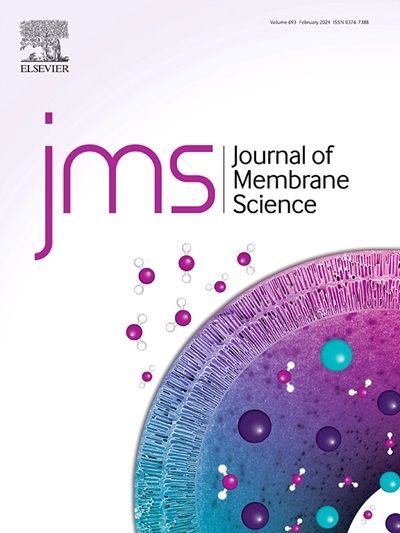Crosslinking PDADMAC/PSS polyelectrolyte multilayer membranes for stability at high salinity
IF 8.4
1区 工程技术
Q1 ENGINEERING, CHEMICAL
引用次数: 0
Abstract
Polyelectrolyte multilayer (PEM) nanofiltration (NF) membranes based on PDADMAC (poly(diallyldimethylammoniumchloride)) and PSS (poly(sodium 4-styrenesulfonate)) are known for their high physical and chemical stability. However, under high salinity conditions, the stability of these membranes is compromised due to weakened electrostatic interactions, leading to increased permeability and decreased retention. This study addresses this challenge by crosslinking PDADMAC/PSS multilayers with the photosensitive, negatively charged crosslinker DAS (disodium 4,4’-diazidostilbene-2,2’-disulfonate tetrahydrate). Initially, this crosslinking is studied on model surfaces, demonstrating full stability against desorption by surfactants at high enough DAS concentrations (1 g·L-1) and at long enough UV exposure (10 minutes). Experiments on PEM membranes demonstrate that DAS crosslinking significantly enhanced the stability of PDADMAC/PSS membranes at high salinity, with no permeability increase or loss of selectivity observed up to 1.5 M NaCl, in contrast to non-crosslinked membranes showing a reversible 61% permeability increase and an irreversible loss in MgSO4 retention of 15%. At 4 M NaCl, the permeability of non-crosslinked membranes increased by 300% versus 90% for crosslinked membranes, again indicating the improved stability of the latter. Crosslinking with DAS further allows tuning of the membrane properties, denser membranes are formed with a lower molecular weight cut-off (MWCO), from around 861 Da of non-crosslinked membranes to around 354 Da of membranes crosslinked with a low DAS concentration (1 g·L-1). DAS introduces negative charges (sulfonic acid groups) into the PEMs, changing the membrane charge from positive to highly negative, as evidenced by the high Na2SO4 retention (∼95%) and low CaCl2 retention (∼7%) of crosslinked membranes. This study demonstrates the potential of crosslinking with DAS to produce stable PDADMAC/PSS NF membranes with tunable selectivity for challenging separation processes in high-salinity environments.

交联 PDADMAC/PSS 聚电解质多层膜,实现高盐度下的稳定性
本文章由计算机程序翻译,如有差异,请以英文原文为准。
求助全文
约1分钟内获得全文
求助全文
来源期刊

Journal of Membrane Science
工程技术-高分子科学
CiteScore
17.10
自引率
17.90%
发文量
1031
审稿时长
2.5 months
期刊介绍:
The Journal of Membrane Science is a publication that focuses on membrane systems and is aimed at academic and industrial chemists, chemical engineers, materials scientists, and membranologists. It publishes original research and reviews on various aspects of membrane transport, membrane formation/structure, fouling, module/process design, and processes/applications. The journal primarily focuses on the structure, function, and performance of non-biological membranes but also includes papers that relate to biological membranes. The Journal of Membrane Science publishes Full Text Papers, State-of-the-Art Reviews, Letters to the Editor, and Perspectives.
 求助内容:
求助内容: 应助结果提醒方式:
应助结果提醒方式:


